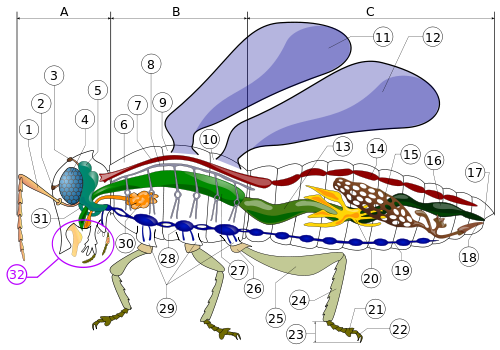Nutrition
This picture was taken from BugGuide.net with permission from Marty Robinson. All rights reserved to Marty Robinson. This is a picture of a Libellula quadrimaculata in action eating another organism.
The four-spotted chaser will go after different organisms depending on which state of life it is in. In its larvae stage it is swimming in lakes or ponds so it will normally go for a many different aquatic insects. Some examples of insects that it will go for are mosquito larvae, aquatic fly larvae, mayfly larvae, shrimp and sometimes small fish and tadpoles. The adults feed on pretty much any prey that is soft-bodied, for example it will feed on mosquitoes, flies, smaller moths, mayflies, flying ants and flying termites. The four-spotted chaser doesn't need a host reproduce, but it sometimes is the host for other organisms. For example it is a host for the parasitic trematode worms.
In the larvae stage they take in water to supply there bodies with oxygen but they don't keep the water in for long. The larvae will squeeze the water out of its body as an attack mechanism to stun its prey. The digestive tract of an adult dragonfly is pretty simple. Once they catch their food, they chew it with their mandibles which is held by their labium, once they swallow the food goes to the thorax into the abdomen where it is digested and the nutrients and extracted from the food and stored as fat, and then whatever is left gets excreted through the anus. (Tillard, R.J. 1917).
The four-spotted chaser has an open circulatory system meaning that there blood or in insects it is known as hemolymph is transported through a series of tubes. The intake of oxygen occurs without lungs, they have a series of internal tubes and sacs that help pipe air directly into there bodies through tracheal tubes found along the abdomen of there body. (Tillard, R.J. 1917). The larva breath through a set of gills that they shed when they transform into there adult stage.
Insect anatomy
scheme
A- Head, B Thorax, C- Abdomen, 1. antenna, 2. ocelli (lower), 3.
ocelli (upper), 4. compound eye, 5. brain (cerebral ganglia), 6.
prothorax, 7. dorsal artery, 8. tracheal tubes (trunk with
spiracle), 9. mesothorax, 10. metathorax, 11. first wing, 12. second
wing, 13. mid-gut (stomach), 14. heart, 15. ovary, 16. hind-gut
(intestine, rectum & anus), 17. anus, 18. vagina, 19. nerve chord
(abdominal ganglia), 20. Malpighian tubes, 21. pillow, 22. claws,
23. tarsus, 24. tibia, 25. femur, 26. trochanter, 27. fore-gut
(crop, gizzard), 28. thoracic ganglion, 29. coxa, 30. salivary
gland, 31. subesophageal ganglion, 32. mouthparts.

